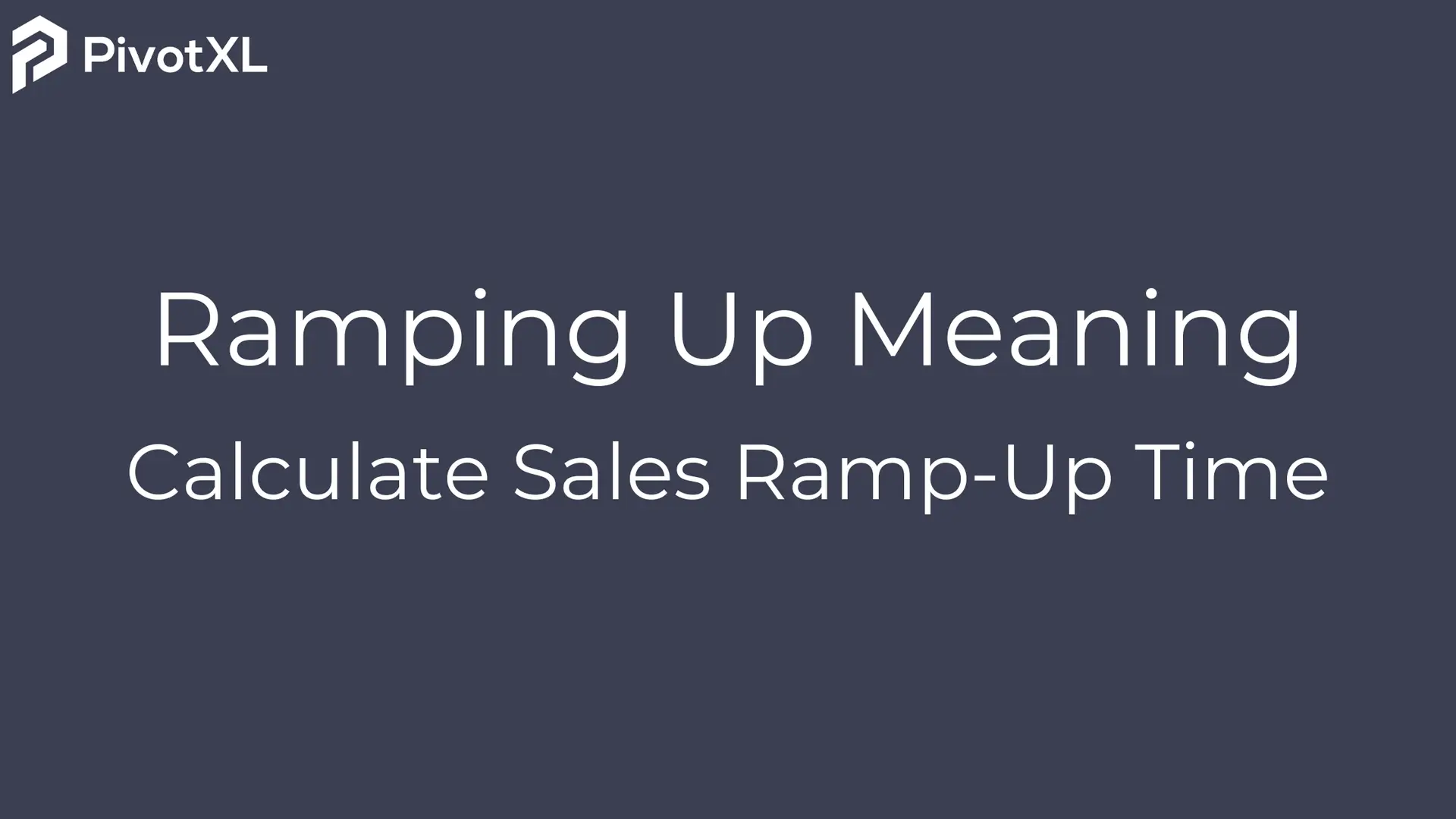In sales, one of the most important yet often overlooked factors in revenue forecasting is ramp-up time. Before a new Account Executive (AE) starts closing deals and hitting quota, they must go through onboarding, training, and hands-on experience with prospects. This adjustment period directly affects sales capacity planning, hiring strategies, and revenue projections.
What Is Ramping Up Meaning In Sales?
The term “ramping up” refers to the process of progressively increasing productivity over time. In a sales context, it defines how long it takes a new AE to become fully productive and consistently meet their sales targets.
Understanding ramping up meaning is crucial because underestimating ramp-up time can lead to missed revenue targets, overworked sales teams, and poor hiring decisions. This article will explore the best methods for calculating ramp-up time, strategies to shorten it, and how to leverage PivotXL to optimize sales capacity planning.
Why Ramping Up Meaning Matters in Sales Planning
When scaling a sales team, leaders often focus on headcount but forget that adding AEs does not immediately translate to increased revenue. Every new hire must go through an adaptation period before becoming a high-performing contributor.
Without factoring in ramp-up time, you might:
- Overestimate sales capacity and miss revenue goals.
- Hire too many or too few reps, leading to budget inefficiencies.
- Misalign sales forecasts, causing inaccurate financial planning.
Common Ramp-Up Challenges
Different factors influence ramp-up time, including:
- Product complexity: More technical or enterprise-level products require longer onboarding.
- Sales motion: Inbound sales roles ramp up faster than outbound roles due to lead availability.
- Experience level: Junior AEs take longer to ramp up than seasoned sales professionals.
- Market dynamics: Some industries or geographies have longer sales cycles, extending ramp-up time.
Understanding these factors is key to refining your hiring strategy and improving sales efficiency.
How to Calculate Ramp-Up Time Accurately
There are multiple ways to estimate ramp-up time, but some methods are more reliable than others. Let’s break them down.
1. Sales Cycle + Fixed 90 Days (Basic Estimate)
A commonly used formula adds 90 days to the average sales cycle length to estimate ramp-up time:
Ramp-Up Time = Sales Cycle Length + 90 Days
Example:
If your average sales cycle is 45 days, this method would estimate an AE will ramp up in 135 days (or 4.5 months).
However, this approach applies a standard formula to all AEs, assuming that every AE ramps up at the same pace. In reality, ramp-up time can vary significantly depending on factors like experience level, product complexity, and individual learning curves, making this a somewhat generalized estimate.
2. Sales Cycle + Training Time + Experience Adjustment
This formula considers training duration and adjusts based on the AE’s experience level:
Ramp-Ramp-Up Time = Sales Cycle + Training Duration + Experience Factor
Example:
- The sales cycle is 60 days.
- Training takes 45 days for a new AE.
- The Experience Factor is that an experienced AE requires only 50% of the normal ramp time, so they need 15 days instead of the typical 30.
Using the formula:
Ramp-Up Time = Sales Cycle + Training Duration + Experience Factor
We calculate:
Ramp-Up Time = 60 days (Sales Cycle) + 45 days (Training) + 15 days (Experience Factor) = 120 days (4 months)
This helps show a more realistic example where the experienced AE’s ramp-up time is reduced based on their prior experience.
3. Time to Reach 100% Quota (Most Accurate Method)
- The most accurate way to determine ramp-up time is by tracking when new AEs consistently hit 100% of their sales quota.
- This method uses real data, removing guesswork.
- Track the time it takes each AE to reach full quota across multiple cohorts.Time to 100% quota may vary based on experience, product complexity, and training effectiveness.
- Provides a clear, data-driven understanding of ramp-up time.
- Helps identify gaps in training, support, or sales strategies.Offers better forecasting and more targeted onboarding plans.
How Ramp-Up Time Varies by Sales Role and Business Type
Ramp-up time isn’t the same for every AE. Key variables include:
| Factor | Impact on Ramp-Up Time |
|---|---|
| Inbound vs. Outbound | Inbound AEs ramp up 2-3 months faster due to pre-qualified leads. |
| Enterprise vs. SMB Sales | Enterprise AEs need 6+ months longer due to complex deals. |
| New Market Entry | Entering a new region can extend ramp-up time by 20-30%. |
Using PivotXL, you can track ramp-up times for different AE roles and adjust hiring accordingly.
How to Reduce Ramp-Up Time and Improve Sales Performance
Shortening ramp-up time means faster revenue generation and better team productivity. Here’s how:
1. Build a Structured AE Onboarding Program
- Standardized training on products, sales playbooks, and objections handling.
- Use PivotXL dashboards to track AE progress through onboarding stages.
2. Implement Continuous Coaching and Mentoring
- Weekly coaching calls to refine pitch and objection handling.
- Shadowing top-performing reps to speed up learning.
3. Create a Data-Driven Ramp-Up Plan
- Set milestones (e.g., 25% quota in month 3, 50% in month 5, etc.).
- Track progress via PivotXL and adjust quotas accordingly.
4. Leverage Sales Performance Data in PivotXL
- Monitor AE activity levels (calls, demos, proposals).
- Identify patterns in high-performing reps and apply best practices.
By optimizing these areas, you can cut ramp-up time by 20-30%.
Applying Ramp-Up Insights for Better Sales Hiring
Once you’ve established your average ramp-up time, use it to inform hiring plans:
- If ramp-up takes 8 months, hire AEs at least 9 months ahead of revenue targets.
- If expansion plans involve new markets, adjust ramp-up estimates accordingly.
PivotXL enables real-time tracking of ramp-up metrics, ensuring that sales teams are scaling efficiently.
Conclusion
Understanding ramping up meaning is essential for effective sales capacity planning. Accurately measuring ramp-up time ensures realistic hiring strategies, prevents over-projection of revenue, and improves overall sales performance.
By leveraging PivotXL for data-driven ramp-up calculations, you can optimize AE onboarding, coaching, and quota setting to reduce ramp-up time and accelerate revenue growth.




